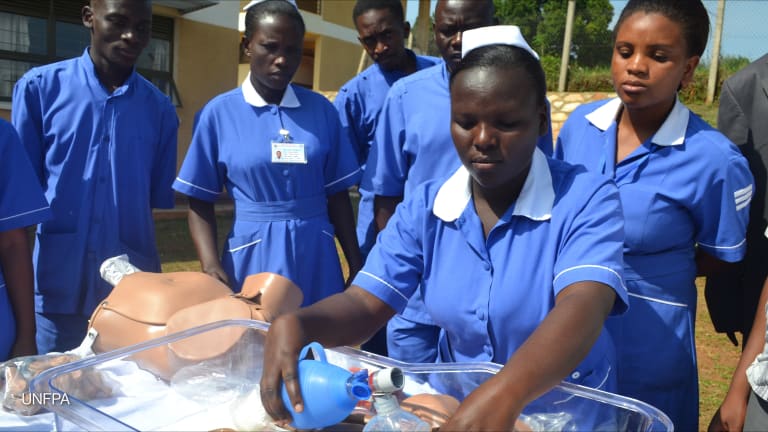How one UN agency is getting countries to help pay for contraceptives
UNFPA is a major provider of donated reproductive health products in many LMICs, but has suffered from funding cuts over the years. Under a new model, governments commit to making mandatory contributions to its supplies program.
In 2021, the United Nations Population Fund introduced a new funding model that gets countries to share the cost of providing contraceptives and maternal health medicines to their populations. The move is meant to ensure predictable and sustainable funding for the Supplies Partnership program, UNFPA’s largest thematic fund which in 2022 accounted for approximately 15% of the agency’s overall funding. The program has suffered from funding fluctuations over the years. UNFPA is a major provider of donated reproductive health products in many low- and middle-income countries. According to the agency, preliminary data so far in 2023 shows it has spent approximately $177 million to get reproductive health products to 54 countries. But external funding has fallen short of the program’s needs, which total $1.25 billion for 2021-2025. To date, it has raised only $782 million, leading to a funding gap of $424 million. The COVID-19 pandemic has also shown the vulnerability of the program to crises. In 2021, it faced an “unexpected” funding cut from the United Kingdom — an 86% reduction from the £144 million the U.K. originally agreed to provide the program — as the U.K. government dealt with the COVID-19 crisis. This led the agency to reduce its annual budget for the program by 33% until other donors stepped in to fill the gap. Meanwhile, countries that receive the donated supplies from UNFPA became reliant on the U.N. agency for much of their reproductive health needs, often diverting funding to other national priorities. With multiple crises — from Gaza to Ukraine, as well as Somalia, South Sudan, Syria, and others — the need to ensure predictable and sustainable funding for the program has become even more critical. “It all depends on every government's willingness to allocate a portion of its ODA [official development assistance], of its taxpayers' money, to this program. So you can never rely that you will get a sustainable flow of this commitment over the coming years,” Ayman Abdelmohsen, chief of the Commodity Security Branch of UNFPA, told Devex. A step away from charity To address the challenges facing the program, UNFPA introduced the subsidization model where countries that receive reproductive health supplies from UNFPA sign a compact committing to share the cost of the program from 2023 onwards. A total of 44 countries have signed the compact, the majority of which are African countries. Under the compact, governments commit to make mandatory contributions to the program and allocate domestic funding for reproductive health products. It also defines governments’ roles in supply planning, as well as clearance, warehousing, and the distribution of commodities. According to Abdelmohsen, this approach “ensures mutual accountability in addressing the reproductive health needs of a country’s population, especially those currently most underserved.” “By moving into this stage … they [governments] understand that it is not a free-for-all, it is not a donation,” he said. This also helps redefine the U.N. agency’s relationship with countries, from being a donor to partners as it moves away from a purely charity model, he said. UNFPA also introduced a match fund in which the agency matches government spending to procure reproductive health products. UNFPA matches the amount equally, or more. To date, 13 countries have used the match fund. According to UNFPA estimates, it has helped unlock an additional $11.5 million in domestic resources, exceeding their target of $9 million. In the Central African Republic, for example, the match fund helped unlock a first-time government contribution of $80,000 for reproductive health commodities. Abdelmohsen said this contribution is “especially notable given that the country is among the lowest-income globally.” In Zimbabwe, the government committed $1.5 million for reproductive health commodities in 2022 and 2023, a significant leap from zero domestic expenditure for this purpose in 2021. Given the positive impact of the fund on the program, it will become a permanent feature of the program starting in 2024, Abdelmohsen said. Outstanding challenges Not all countries are able to sign the compact. Countries such as Afghanistan, Haiti, Sudan, and South Sudan, for example, are exempted given their humanitarian situation. In these countries, UNFPA continues to provide the bulk of reproductive health products and sometimes distributes them. But even in countries that have agreed to share the cost of reproductive health products, delivery can still be an issue. He said there have been cases when they procured the products, but when they arrived in the country, the supply chain system was already overwhelmed. “So when you provide these commodities, you overwhelm it even more, so many of these commodities … end up sitting badly stored in some of the warehouses, and they don't make it to the end user,” he said. “That still is one of our major challenges, which we are dealing with right now,” he added. Another challenge is the quality of the service delivery in countries, as well as the capacity of governments to generate demand for reproductive health products. UNFPA doesn’t work on demand generation, Abdelmohsen said. Even with additional domestic resources, there remain huge gaps in ensuring everyone who needs contraceptives and other reproductive health supplies has access to them. According to Abdelmohsen, UNFPA coordinates with governments and other in-country partners on countries’ national commodity supply plans. This helps with forecasting and mapping of funding sources and gaps across partners to prevent any potential shortages or stockouts. But even after identifying all funding sources, in 2022, there remained a funding gap of $150 million to ensure these commodities were made available in the countries covered by the UNFPA program then. These national supply plans are based on what health systems can deliver, meaning the potential funding gap to meet the needs of all women and adolescent girls is likely bigger, Abdelmohsen said. “We know donors are facing competing demands including from the record levels of humanitarian crises worldwide … Notably, more than half of the UNFPA Supplies programme countries are currently grappling with one or more humanitarian situations meaning the support we provide is especially vital,” he said. However, “UNFPA remains hopeful about sustaining funds for UNFPA Supplies, as donors demonstrate strong commitment to ensuring that women and girls can exercise their choices and rights,” he added.
In 2021, the United Nations Population Fund introduced a new funding model that gets countries to share the cost of providing contraceptives and maternal health medicines to their populations.
The move is meant to ensure predictable and sustainable funding for the Supplies Partnership program, UNFPA’s largest thematic fund which in 2022 accounted for approximately 15% of the agency’s overall funding. The program has suffered from funding fluctuations over the years.
UNFPA is a major provider of donated reproductive health products in many low- and middle-income countries. According to the agency, preliminary data so far in 2023 shows it has spent approximately $177 million to get reproductive health products to 54 countries.
This story is forDevex Promembers
Unlock this story now with a 15-day free trial of Devex Pro.
With a Devex Pro subscription you'll get access to deeper analysis and exclusive insights from our reporters and analysts.
Start my free trialRequest a group subscription Printing articles to share with others is a breach of our terms and conditions and copyright policy. Please use the sharing options on the left side of the article. Devex Pro members may share up to 10 articles per month using the Pro share tool ( ).
Jenny Lei Ravelo is a Devex Senior Reporter based in Manila. She covers global health, with a particular focus on the World Health Organization, and other development and humanitarian aid trends in Asia Pacific. Prior to Devex, she wrote for ABS-CBN, one of the largest broadcasting networks in the Philippines, and was a copy editor for various international scientific journals. She received her journalism degree from the University of Santo Tomas.








